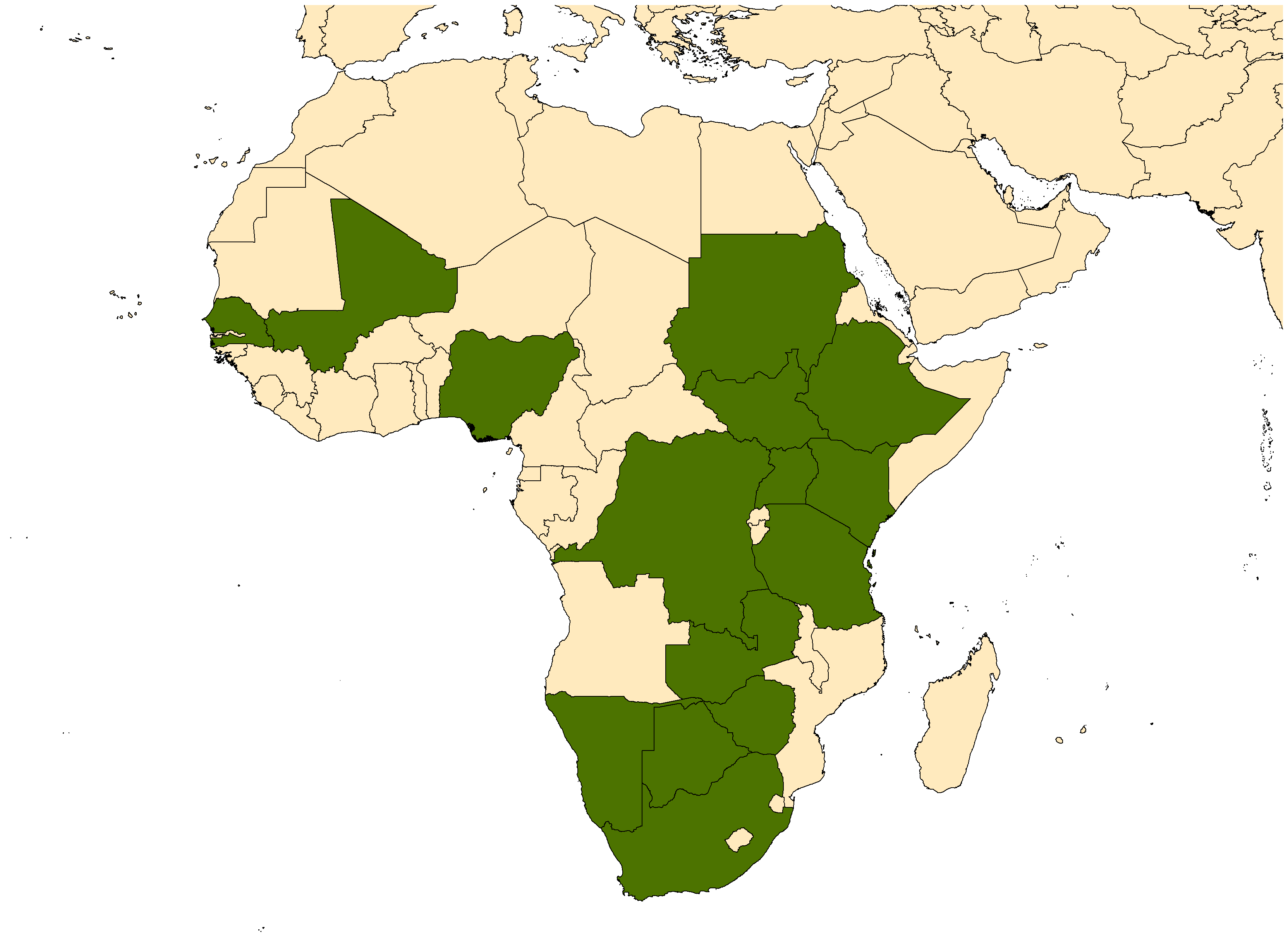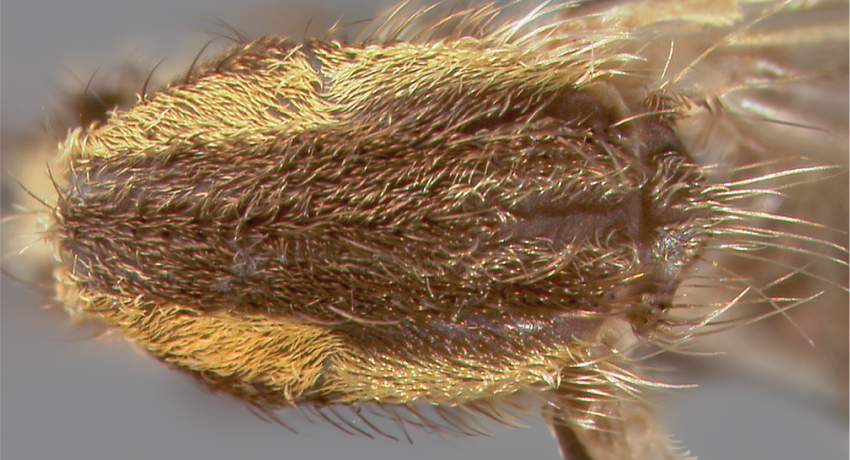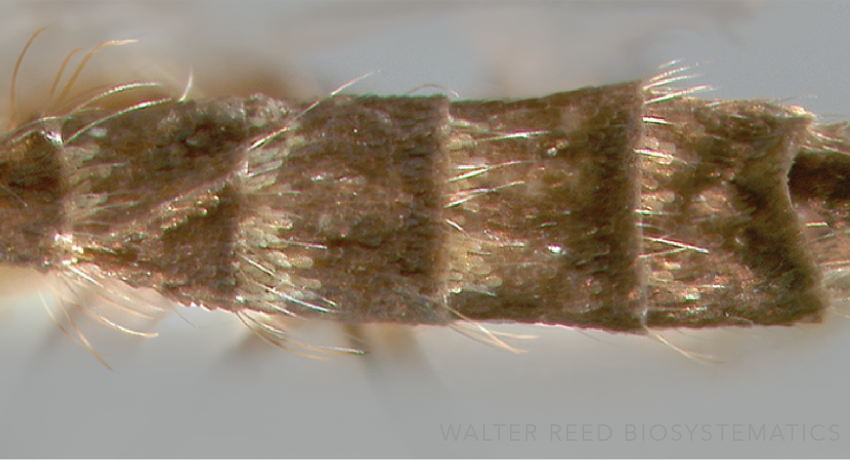AFROTROPICAL REGION
Etymology: Bruce M. McIntosh
Aedes mcintoshi is widely distributed in Africa, extending south from sub-Sahelian Africa on both the west and east sides of the continent. The species belongs to the Lineatopennis Group of the Aedes subgenus Neomelanoconion together with Ae. lineatopennis (Ludlow), Ae. circumluteolus (Theobald), Ae. luridus McIntosh, Ae. luteolateralis (Theobald), and Ae. unidentatus McIntosh. For many years, the true identity of Ae. mcintoshi was hidden—misidentified as the morphologically similar Austro-Oriental species Ae. lineatopennis, originally described from the Philippines—and earlier records of Ae. lineatopennis in Africa are considered to refer to Ae. mcintoshi. Landscape genetics approaches supported the single species status of Ae. mcintoshi, but revealed high genetic variation in subpopulations, that was correlated with soil clay content and recent precipitation.
Type locality: Onderstepoort, Transvaal, Republic of South Africa
Type depository: U.S. National Museum, Washington, D.C., United States (USNM)
DIAGNOSTIC CHARACTERS (Click photos to view; mouse over and click large photo to zoom in.)
ADULT (illustrated): Head: Vertex with narrow decumbant scales; numerous erect forked scales on head, not restricted to occiput. Thorax: Scutum bordered with lateral band of yellow scales from anterior promontory to scutellum; scutellar scales all narrow; acrostichal and dorsocentral setae present; paratergite bare; mesepimeron with a lower anterior seta. Wings: Veins C, R4+5 and 1A all dark-scaled; veins Rs, R2+3 and M with white plume scales. Legs: Fe-I–III without pale bands. Abdomen: Terga with basal pale bands.
LARVA (not illustrated): Head: Antenna spiculate; seta 1-A small, with few branches; seta 6-C slightly posterior to a small seta 4-C; seta 7-C positioned anterior to setae 4–6-C. Terminal segments: Pecten spines extend ≥ 0.5 x length of siphon; seta 1-S usually at end of, or beyond, pecten; precratal setae present; stout comb scales in a single row.
TAXONOMIC KEYS
Jupp 1996
![]()
WRBU – Aedes – Afrotropical Region – Larva
Exemplar DNA sequences
Ae. mcintoshi COI: KJ940551–692, KJ940755–59, KU187018
BIONOMICS
Immatures
Aedes mcintoshi is a floodwater mosquito, and immatures are typically found in grassy ground pools and residual stream pools. Aedes mcintoshi has been collected alongside as Ae. unidentatus in South Africa and Ae. circumluteolus in Kenya.
Adults
Aedes mcintoshi females bite at night, preferring cattle, but will readily feed on people outdoors. Females deposit their eggs in the upper layer of soil, in grassy sites most likely to flood. Eggs can remain in a dormant state for years, hatching only following sustained submersion. Egg desiccation tolerance in floodwater mosquitoes is often associated with transovarian transmission of viruses between successive generations. Aedes mcintoshi is a major vector of Rift Valley fever virus in Africa.
DISTRIBUTION NOTES
Angola, Botswana, Democratic Republic of the Congo, Ethiopia, Gambia, Kenya, Mali, Nigeria, Republic of South Africa, Senegal, Sudan & South Sudan, Tanzania, Uganda, Zambia, Zimbabwe.

WRBU VECTOR HAZARD REPORTS
None; View other WRBU Vector Hazard Reports
Available GIS Models:
None
IMPORTANT REFERENCES (full citations below)
Knight & Hull 1953 (M*, F, L*; bionomics, distribution; as lineatopennis)
Huang 1985: 109 (M*, F*; differentiation from lineatopennis)
Zavortink 1987: 2 (distribution)
Linley & Turell 1994: 1 (E*)
Jupp 1996 (M*, F*; key)
Zavortink 2004 (taxonomy)
CURRENT SYNONYMS
None
CITED REFERENCES
Huang, Y.-M. (1985). A new African species of Aedes (Diptera: Culicidae). Mosquito Systematics, 17(2), 108–120.
Jupp, P.G. (1996). Mosquitoes of southern Africa. Culicinae and Toxorhynchitinae. Ekogilde Publishers, Hartebeespoort, South Africa, 156pp.
Knight, K.L., & Hull, W.B. (1953). The Aedes mosquitoes of the Philippine Islands. III. Subgenera Aedimorphus, Banksinella, Aedes, and Cancraedes (Diptera, Culicidae). Pacific Science, 7, 453–481.
Linley, J.R., & Turell, M.J. (1994). Ultrastructural descriptions of the eggs of Aedes mcintoshi and Aedes circumluteolus (Diptera: Culicidae). Mosquito Systematics, 26(1), 1–10.
Zavortink, T.J. (1987). Biosystematics of Aedes (Neomelaniconion) for the period 5 May 1986 – 4 May 1987. Annual report for contract DAMD17-86-C-6134. Available from: https://archive.org/details/DTIC_ADA183519/page/n2
Zavortink, T.J. (2004). Conservation of the names Aedes albothorax, Ae. circumluteolus, and Ae. mcintoshi. Journal of the American Mosquito Control Association, 20(2), 197–198.
CITE THIS PAGE
Walter Reed Biosystematics Unit (Year). Aedes mcintoshi species page. Walter Reed Biosystematics Unit Website, http://wrbu.si.edu/vectorspecies/mosquitoes/mcintoshi, accessed on [date (e.g. 03 February 2020) when you last viewed the site].













































































































































































